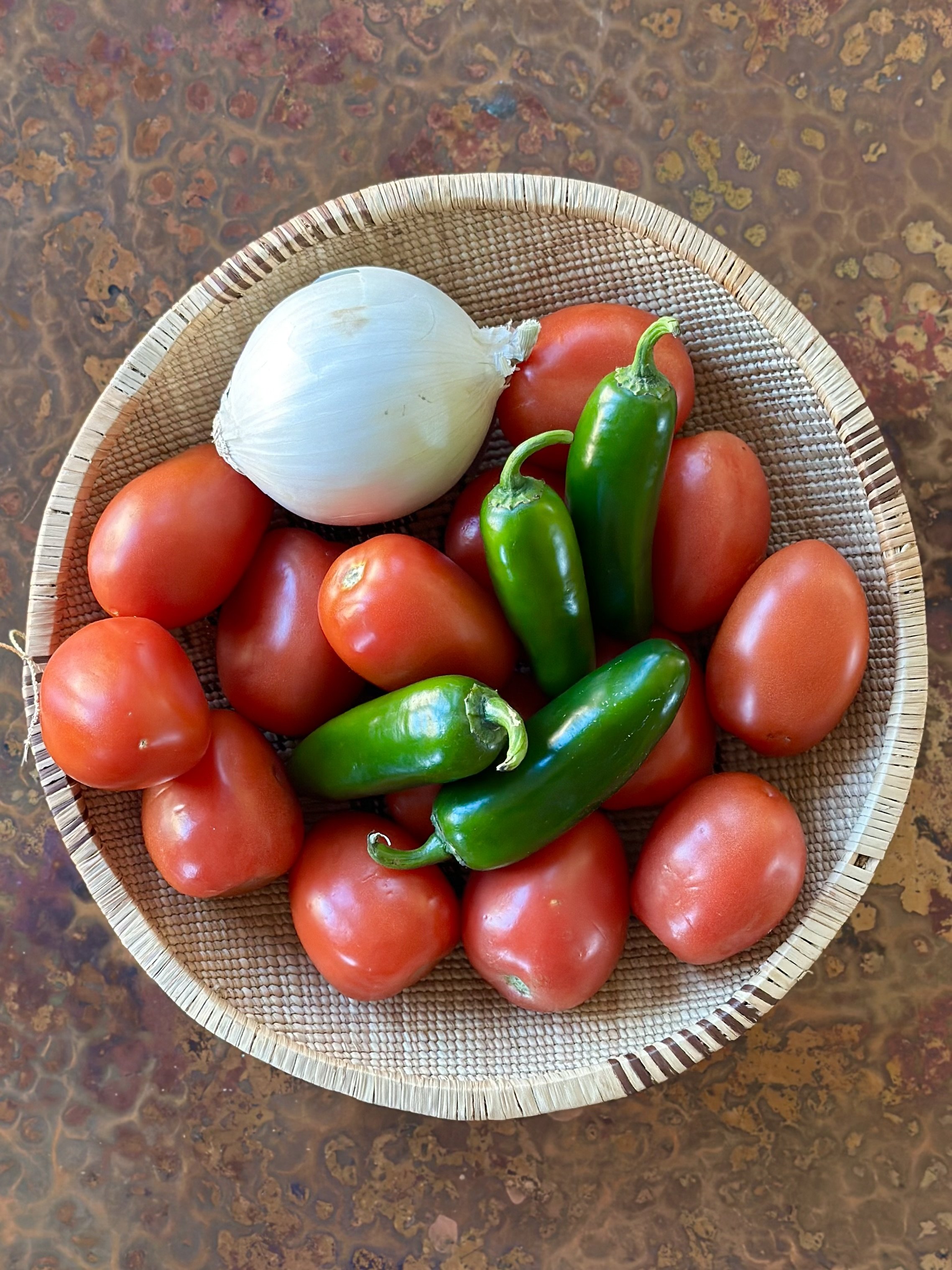Roasted Salsa Mexicana
My childhood was pretty idyllic. I lived like a wild thing out in the countryside of a farming community, full of peach orchards. My little sister was my playmate and we had lots of adventures riding bikes down the lane, splashing in the mud, playing dress up in my mom’s old dresses in the alfalfa field, and I had an orange cat named Tigger that would regularly bring us mice offerings. And I ate homemade salsa.
My Grandma Salazar lived a few minutes away — and her cooking was legendary among friends and family in Grand Valley. She and my grandpa tended a large garden behind their house and I have so many memories of coming over and finding them in the garden, sun hats on, at work. Grandma made salsa from all of that homegrown produce every year, and she would dole out equal allotments to her children. When we’d eat through most of our jars, I have memories of my mom saying — “this is our last jar of salsa!” — in a tone that implied, “you’d better appreciate it.”
No one continued the salsa-making tradition in large batches, canned and stored away for the winter, after my grandparents grew too old to garden. I think it’s because homemade in our family was directly related to home-grown whenever possible.
And times have changed. No one lives in a place with extra farmable land in the back yard with an irrigation ditch running through, like Grandma and Grandpa did. And no one has that kind of time in our frantic modern schedules. Downtime isn’t spent hoeing rows and pulling weeds anymore.
But we all still love salsa. RIGHT? And it turns out, homemade is still a thousand times more delicious than store-bought, even if the tomatoes didn’t grow a short walk from the house.
After my semester in Oaxaca, I began making fresh salsas de la mesa: Salsa Verde, Salsa Mexicana, Pico de Gallo. But whatever my grandma did was just another level entirely. Cooking the veggies and making shareable batches wasn’t on my radar. Who has time?
But one winter I had a need for salsa, and my stubborn but correct belief that tomatoes grown “out-of-season” aren’t as delicious had kept me from making any outside of harvest months.
I’m not sure why it took me so long, but that’s when I had the idea to roast the veggies. Yep. Kinda humbling that it took me so long, actually. But if you cook enough, you KNOW that roasting brings out the best flavors and you can even draw out flavor when it’s practically undetectable in raw form. So, I took my Salsa Mexicana veggies, and I roasted them under the broiler! And instead of painstakingly chopping the veggies, I gave them a whirl in the blender. The flavor was fantastic, and this method was fast. And the best part? I can make bigger batches and share! Canning isn’t necessary because the entire process is so quick and simple. When you run out, just make more when you need it.
As I do with every recipe I share, I have been testing this for a long time: over two years. And it’s foolproof. Now it’s your turn to share salsa happiness!
…
Roasted Salsa Mexicana
Recipe by Stephanie Kunstle — inspired by my cooking classes with Chef Armando from la Universidad Mesoamericana Oaxaca, 1999.
Note: this recipe can be doubled or tripled and will fit into a blender with 64 oz or 2L max capacity. One recipe makes approximately 24 oz.
For a quick preview of what this process looks like or for a quick escape from your reality, see my reel on Instagram.
Ingredients:
6-8 Roma tomatoes
1/4 of a large white onion
2 large jalapeños (or 3 small)
2 tsp pink Himalayan salt (or other high quality fine grain salt)
Preparation:
Preheat your broiler for about 10-15 minutes. Rinse your veggies, and peel and slice your onion into quarters.
Place veggies on a baking sheet and broil for 15-20 minutes — turning every 5-8 minutes — on the top rack of your broiler (about 3 inches from the top), until well roasted and blackened but not charred. You don’t want charcoal so pull it before the skins lose their texture and become crumbly.
Let cool for a few minutes. Cut off stem ends of tomatoes and jalapeños. Slice jalapeños lengthwise, and scape out seeds.
Blend/pulse with about 1-2 tsp salt until preferred chunky texture (don’t over-blend or you’ll get weird baby food)… taste for salt, add more if necessary. A quick note on salt: 2 tsp almost always works for me, but every now and then it’s too much. It just depends on the veggies themselves. So, start with whatever you’re comfortable adding and add more as needed. You can’t remove salt once it’s in!
Serve with chips, over tacos, with quesadillas, or add a dollop to guacamole! Refrigerate if you’re not eating it right away. Enjoy!




